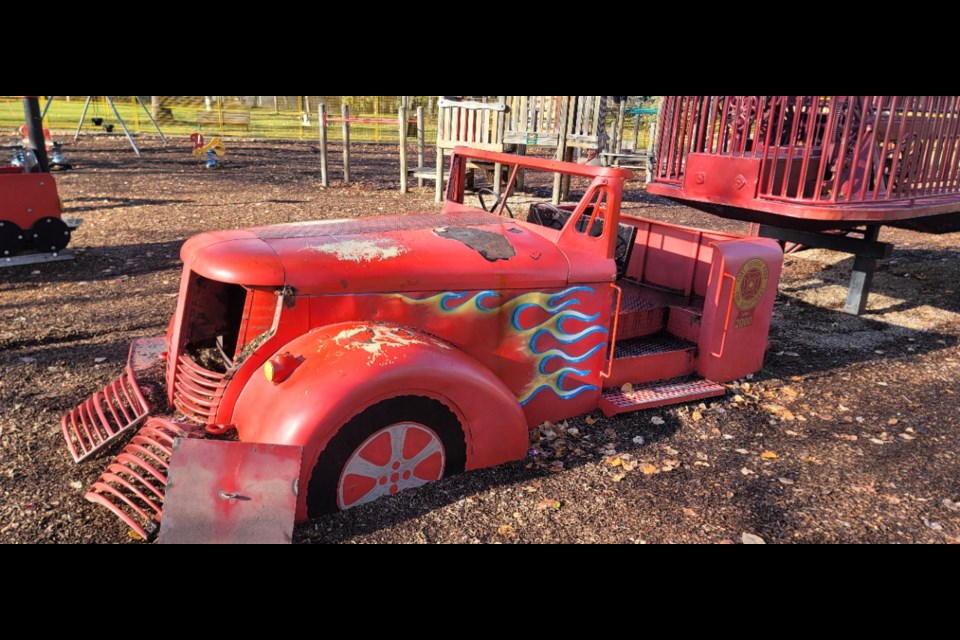City crews have erected a wire fence around the perimeter of the Rotary Playground at Lheidli T’enneh Memorial Park and work will continue this week to dismantle the playground equipment.
Built in July 2000 as a volunteer project that involved Rotarians and their families, the playground no longer meets safety standards and that means the old Fort George Park Fire Department fire truck feature that kids used to climb will soon be removed and placed into storage.
According to a condition assessment conducted by an external audit company:
“The fire truck has become dated. There is much to repair on the existing device due to ongoing wear and tear. It was noted on both sections of the fire truck (that) over time, wear and tear damage has occurred to parts of the fire truck climber, exposed metal portions, damage to finishing on the front portion of the fire truck.
“The slide was noted to have many problems and concerns as noted in the current standard in particular due to ongoing wear, damage and separations that are occurring on the slide bed in several areas. Slides, due to their design, are considered to be a device that a child will descend uncontrolled, no way to stop. Due to this uncontrolled descent there is a need to ensure that all slide beds are smooth with no openings were clothing, hands, fingers, etc., could get caught and result in injury.”
In April, city staff hired Canadian Recreation Solutions to design a new playground that reflects the unique geography and diverse culture of Prince George. Scheduled for completion by the fall of 2025, the new design will incorporate the Little Prince train that runs through the park and will bring back the vintage fire truck feature in a safer form. The design plan is still in its early stages.
The fire truck and other playground features will be taken down over the next few days to allow for reconstruction of a new playground next spring. The cost of the rebuild on the same site, estimated at $3 million, is pending city council approval.
“The concept for the new playground has a strong focus on accessibility,” says the consultant’s report.
“Accessible features including a rubber surface (helps those using wheelchairs/walkers/crutches to access the playground), an accessible swing, ramps to access the railroad bridge and train play structure, a spinning play feature, tactile sensory activities at many different heights, musical activities, a quiet sensory area for kids who need a calmer environment, and more.”
The playground was built over two days in July 2000 by a group of 50 Rotarians and their friends and families. A sign that commemorates the playground opening on Sept. 26, 2000 says it was designed for youth of all ages and accessibility levels. But standards on accessibility and the city’s insurance liabilities have obviously changed since then.
The playground is located just north of The Exploration Place museum building, not far from the Lheidli T’enneh Village Cemetery. Before work can proceed on installing the new playground the city is mandated by the Heritage Conservation Act to conduct an archaeological assessment to avoid disturbing any human remains buried near the park site.
"The entirety of the Lheidli T’enneh Memorial Park is a protected archaeological site that requires archaeological monitoring and site mitigation obligations under the Heritage Conservation Act,” said Blake McIntosh, the city’s civic operations director, in a report to council.
“Considering the high archaeological sensitivity and cultural value of the area, innovative approaches will be employed to minimize earthwork and unnecessary disturbances. Electromagnetic (EM) and ground penetrating radar (GPR) will be used to survey the area currently in use as a playground to provide a more inclusive picture of potential subsurface targets. Geophysical data interpretations may be attained with a greater degree of confidence in areas that are undisturbed and in favourable soil conditions. The consultant must have unobstructed access to the project area, including the removal of all existing play equipment, fall protection and mulch layers. This work is scheduled for this fall and will accommodate the seasonal reduction in use at the park/playground.”
An archaeological assessment would determine the potential negative impacts the playground project would have on a protected site like Lheidli T'enneh Memorial Park. If any artifacts are found, results would be shared with the Lheidli T'enneh and a joint decision would be made on how best to proceed, said city spokesperson Claire Thwaites.

.png;w=120;h=80;mode=crop)

